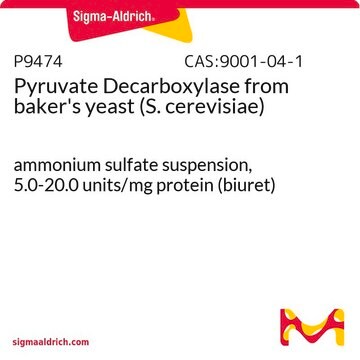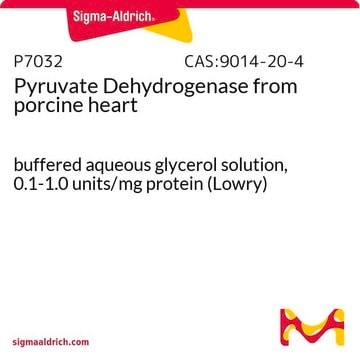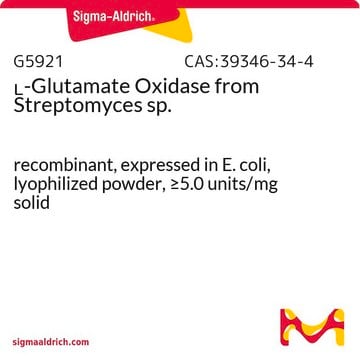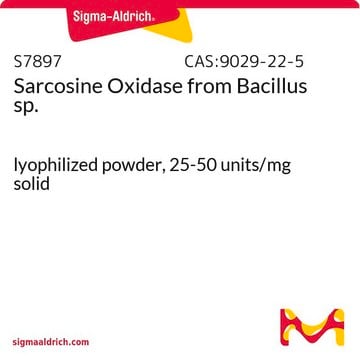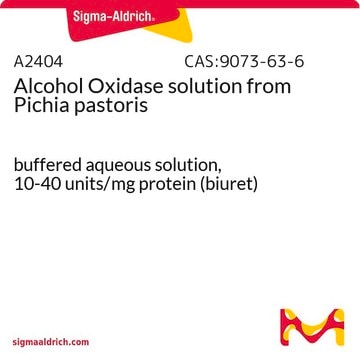P4105
Pyruvate Oxidase from Aerococcus sp.
lyophilized powder, ≥35 units/mg protein (biuret)
Synonym(s):
Pyruvate: oxygen oxidoreductase (phosphorylating)
Sign Into View Organizational & Contract Pricing
All Photos(1)
About This Item
Recommended Products
biological source
bacterial (Aerococcus spp.)
Quality Level
form
lyophilized powder
specific activity
≥35 units/mg protein (biuret)
storage temp.
−20°C
Application
Pyruvate Oxidase (PoxB) converts pyruvate directly to acetate and CO2. It is used to study pyruvate metabolism. It is used to study aerobic metabolism of bacterium, such as Lactobacillus plantarumand Streptococcus pneumoniae.
Pyruvate Oxidase from Aerococcus sp. has been used in the amplex Red-based fluorescence assay for pyruvate. It is suitable for use in the preparation of biosensor for determination of thiamine (vitamin B1), and as a component in the constant part of the multi-enzyme biocatalytic cascade for the determination of biomarkers for traumatic brain injury (TBI) and soft tissue injury (STI).
Biochem/physiol Actions
Pyruvate Oxidase consists of four subunits with identical molecular weights. PoxB reacts with certain aldehydes and phosphate can be replaced by arsenate. Oxygen as well as several artificial compounds can function as electron acceptors. Pyruvate Oxidase is activated by phospholipids as well as monomeric and micellar amphiphiles.
Pyruvate Oxidase oxidises pyruvate to form acetate, hydrogen peroxide and carbon dioxide. Pyruvate oxidase requires flavin adenine dinucleotide (FAD), thiamine pyrophosphate (TPP) and magnesium as cofactors for its catalytic activity. Thiamine activates pyruvate oxidase activity.
Unit Definition
One unit will produce 1.0 μmole of H2O2 per min during the conversion of pyruvate and phosphate to acetylphosphate and CO2 at pH 6.7 at 37 °C.
Physical form
Lyophilized powder containing buffer salt and sugar
signalword
Danger
hcodes
pcodes
Hazard Classifications
Resp. Sens. 1
Storage Class
11 - Combustible Solids
wgk_germany
WGK 3
flash_point_f
Not applicable
flash_point_c
Not applicable
ppe
Eyeshields, Gloves, type N95 (US)
Certificates of Analysis (COA)
Search for Certificates of Analysis (COA) by entering the products Lot/Batch Number. Lot and Batch Numbers can be found on a product’s label following the words ‘Lot’ or ‘Batch’.
Already Own This Product?
Find documentation for the products that you have recently purchased in the Document Library.
Customers Also Viewed
B Sedewitz et al.
Journal of bacteriology, 160(1), 462-465 (1984-10-01)
Under aerobic growth conditions Lactobacillus plantarum produced acetic acid in addition to lactic acid. It was found that lactic acid was predominantly produced at first, and then when the carbohydrate was nearly exhausted, lactic acid was metabolized further to acetic
Multi-enzyme logic network architectures for assessing injuries: digital processing of biomarkers
Halamek J, et al.
Molecular Biosystems, 6(12), 2554-2560 (2010)
Activation of pyruvate oxidase by monomeric and micellar amphiphiles.
R Blake et al.
The Journal of biological chemistry, 253(6), 1963-1971 (1978-03-25)
B Sedewitz et al.
Journal of bacteriology, 160(1), 273-278 (1984-10-01)
Pyruvate oxidase (EC 1.2.3.3) was isolated and characterized from Lactobacillus plantarum. The enzyme catalyzes the oxidative decarboxylation of pyruvate in the presence of phosphate and oxygen, yielding acetyl phosphate, carbon dioxide, and hydrogen peroxide. This pyruvate oxidase is a flavoprotein
Rachel Benisty et al.
Biochimica et biophysica acta, 1801(9), 1098-1104 (2010-07-06)
FabF elongation condensing enzyme is a critical factor in determining the spectrum of products produced by the FASII pathway. Its active site contains a critical cysteine-thiol residue, which is a plausible target for oxidation by H2O2. Streptococcus pneumoniae produces exceptionally
Our team of scientists has experience in all areas of research including Life Science, Material Science, Chemical Synthesis, Chromatography, Analytical and many others.
Contact Technical Service




